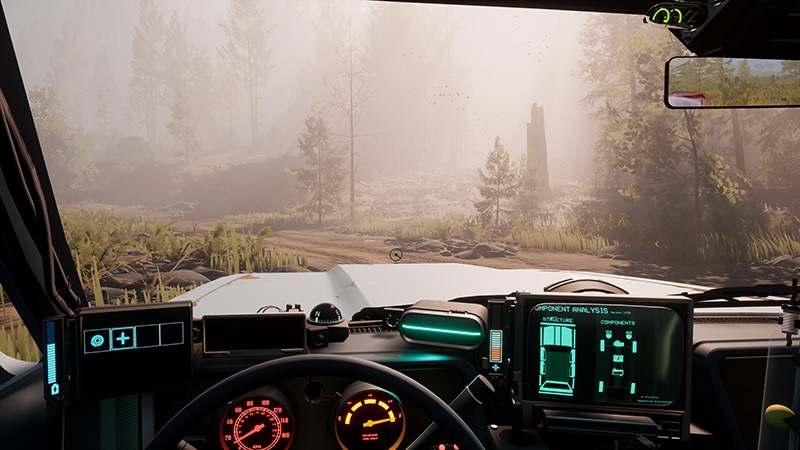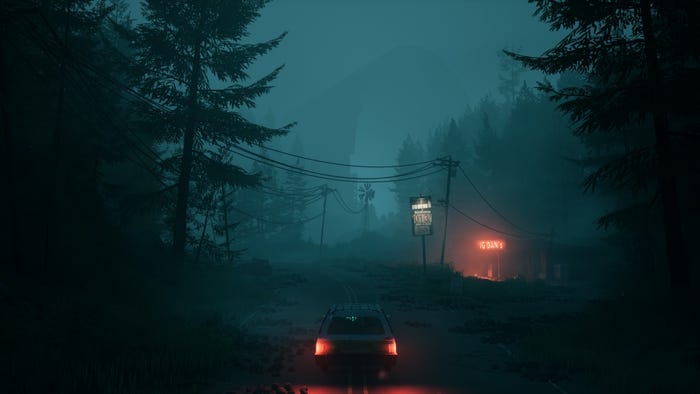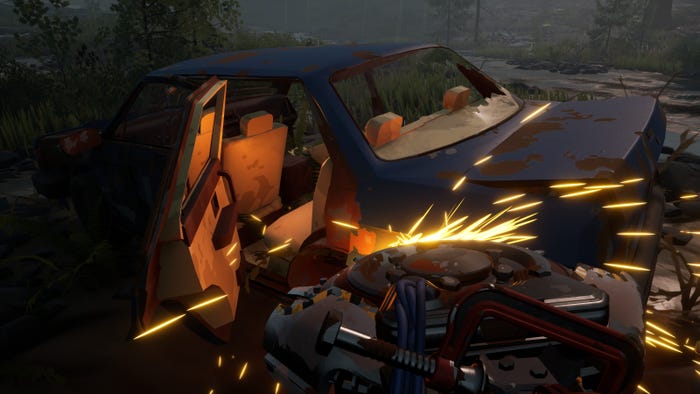Trending
Opinion: How will Project 2025 impact game developers?
The Heritage Foundation's manifesto for the possible next administration could do great harm to many, including large portions of the game development community.

It was a throwaway line from Pacific Drive game director Seth Rosen that I just had to follow up on. He'd been describing the ins and outs of the game's "quirk" system, which ascribes a number of "if-then" traits to the player's car. For instance if the player turns the steering wheel, then the headlights will dim, for instance.
Those quirks, and many other traits, were applied to what he referred to as the car's "soul."
I cut him off. "On your car's...what? Sorry?"
"The soul," he replied.
There was a pause. A nervous laughter came from the audience. "We're coming back to that," I swore.
This exchange came from a Q&A hosted by the Boston GameDev meetup at MIT—I'd been asked by the organizers to host the event and quiz Rosen about the design and production process of Pacific Drive. Rosen, free from the shackles of marketing the game (and coming off a cross-country road trip filled with plenty of spooky anomalies of his own) was game to crack open the game's hood and explain the nitty-gritty details of Ironwood Studios' driving survival game.
The car's "soul" is just one of many little systems that show how Rosen—a veteran of simulation games like Don't Starve and Mafia III—helped his colleagues cobble together to make the driving survival game sing. As he explained how the game systems evolved, it was fascinating to hear how so much of what makes Pacific Drive special and unique wasn't all that different from any other game, but by applying familiar systems to creative director Alex Dracott's vision of a spooky driving game in the Olympic Peninsula, the team was able to make a driving game unlike any other on the market.
From car souls to health bars and hands-on maintenance mechanics, Rosen had a lot to say about why Pacific Drive just "works." Here are lessons from the experience that can help make your game stand out.
First, let's dig into that "soul."
In Pacific Drive's code there lays an Unreal blueprint called "IA_Internal_Soul" that tracks the aforementioned quirks and all of the car's stats. "It's the central repository for all things 'car'" he said. By storing information like how far the car has travelled, the game can calculate wear and tear on car parts and generate obstacles the player is (or maybe isn't) ready to face.
It's a useful method for calculating where "friction" needs to be applied in the Pacific Drive experience. Rosen is very particular about "friction" in design—he has strong opinions about survival games (which he described as generally being 'time management' games), and how friction in the player experience that slows them down and makes them fiddle with a game mechanic can be a core part of making sure the game is fun.

Image via Ironwood Studios/Kepler Interactive.
The trick with applying this common concept in Pacific Drive is that the friction is often applied where players wouldn't expect to find it in similar kinds of games.
A good example of this is in the car's customization system—the very first design feature Rosen tackled when he joined the team. When he was asked to consult on Pacific Drive, customizing the player's car took place in a menu. It allowed players to quickly swap and repair parts in a quick and efficient manner.
But Rosen's gut instinct was that this system was too quick, and too efficient. Making the player a "Zone mechanic" (i.e a mechanic who has to master the weird physics of the "Zone") was a core pillar of the game design, and swapping car parts in a menu was easy, but not necessarily fun.
He pressed the team to switch to a customization and repair loop that involved walking around the car, making parts at a work bench, and physically repairing it with tools. The process is slower, but it helps drive player investment in the car and nudges the player into thinking like a real-world mechanic. If you've played the game and wandered around the garage thinking "alright, the car needs this, where did I leave that part..." then you've felt the impact of Rosen's choice of friction.
But Rosen didn't see the game as just being about making easy tasks hard. Though the quirk system is meant to let every part of the car's functions interact with each other—steering, parking brakes, headlights, radio, etc.—combinations that get in the way of core gameplay are downplayed or even shut off altogether.
For instance, if the player takes the car out of park, it shouldn't go back into park. "It's a driving game, you have to be able to drive," he quipped.
The "survival" part of "driving survival" game is actually creates a surprising clash in Rosen's design sensibilities. To put it bluntly, Rosen hates survival games.
Okay "hates" might be a strong word—he doesn't find them to be evil or anything—but he doesn't enjoy playing most of them. To him survival games operate on a spectrum running from "treehugger" to "tree-puncher" spectrum.
"A 'tree-puncher' game is a game where your entire relationship to the world is extractive," he said, an echo of many critiques of games that reinforce a "colonialist" ideology with how players interact with the world. "Treehugger games" are games where the environment has its own ecology and the player isn't at the center of it. "So much of those experiences are about [the player] figuring out how they fit into that ecology, seeing something new and poking it with a stick...to see what happens," he said. "I find that those experiences are so much more interesting."
A fascinating late twist in development that sealed the deal on the "treehugger" design philosophy had to do with item damage. With only a few months until the game had to ship, Rosen became suddenly convinced that one new mechanic would make the game sing: health bars.
Originally, when players wanted to harvest an item, they would select the tool, navigate to the resource, an animation would play, and the resource would break apart, leaving harvestable items behind.
Something tugged at Rosen's instincts, and he decided to test out a new idea: giving all items in the game health bars that could be chipped away at using tools or damage from the environment.
"It opened up all of these cool interactions," he said. If players are in dire straits and missing a key tool to harvest resources, they can use other sources of damage dealing to get what they need. If they don't have the buzzsaw-like "scrapper" item used to cut through metal, they can just ram a car into another car instead.

Image via Ironwood Studios/Kepler Interactive.
It's a harvesting mechanic, which may feel overly extractive at first glance, but it also creates more in-world interactions that exist without the player. If a stray explosion from a Tourist (creepy exploding mannequins that move when the player isn't looking) blows up a resource in the environment, players can find useful items in the debris.
"Tree puncher" games also regularly bring players to what Rosen called "the plateau of stability." It's a state of gameplay where the threats that first pressured a player to gather resources and craft items aren't threats anymore. There may be some gameplay to pursue after that—using the game's tools to build a massive settlement or monument of some type—but without that tension, he feels that such games become far less interesting.
He noted that Outer Wilds is a game that fits the "treehugger" archetype, and he was surprised to see Pacific Drive compared to it in the media coverage around the game. "In hindsight, it makes a lot of sense. It's that same sort of discovery process."
Game designers chasing market trends right now have every reason to chase that "tree puncher" trend. Players want to gather resources and build big bases.
But when you follow Rosen and Ironwood Studios down the path of the treehugger, you might make a game where the player hauls ass in a station wagon through the woods, running from a weird floating orb that wants to steal their bumper.
You May Also Like